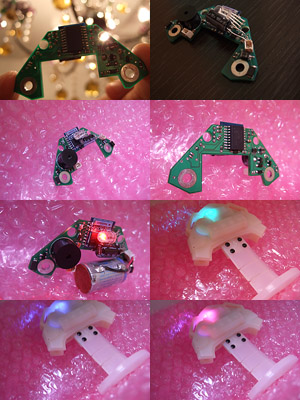| << return to blog entries
2010-04-13 09:26:56 (4378 views) Don't worry - we're not back to the drawing board. This receiver prototype was created as a sample; the PCB assembly house will use this to avoid screwing up!
 We were able to get professional no-clean flux from the PCB factory and using this we resolved all problems related to hand assembly of boards. Chiefly, the problem had been erratic current consumption. This was tracked down to the flux we were using which contained conductive material. Using this flux yielded a 100% reliable and functional board. We were able to get professional no-clean flux from the PCB factory and using this we resolved all problems related to hand assembly of boards. Chiefly, the problem had been erratic current consumption. This was tracked down to the flux we were using which contained conductive material. Using this flux yielded a 100% reliable and functional board.
The consumption in standby mode is 0.1mA. This includes the TVS diodes, two strategically placed components that prevent electrostatic electricity from damaging the circuit, but which also have some quiescent current.
The peak shown in the graph below (smoothed out by a capacitor) is the activation of the RF circuitry which periodically wakes to listen to incoming packets (about once every half second). After awakening it takes almost 3ms for all the relevant circuitry to become operational including the crystal oscillator used for RF communication, the oscillator and so forth. This is evident from the waveform (the little bump on the left is the "wake up" period). The real receiving time is 6ms, enough for packets to be received when the remote control is transmitting. For the savvy ones out there, current was measured through a 10ohm resistor so the reading must be interpreted as milliamperes and divided by 10.
This graph illustrates the RF wake cycle.

Some calculations. 0.1mA for 504ms sleep time, 2mA for 3ms wake time and about 22mA for 6ms... how much is the average consumption and how long will the battery last?
I(avg) = (0.1*504 + 2*3 + 22*6)/(504+3+6) = (50.4+6+132)/513 = 0.367 mA
Since one of these batteries has a capacity of 750mAh when the average current is around 0.5mA, then we can conclude the battery will last 750/0.367 = a whopping 2043 hours. That is 85 days or 2.8 months.
Actually the pulse can still be adjusted - not sure why the on time is 6ms now, it used to be 3ms and that still worked, and the off time used to be 700ms. With some tweaking the battery life could go up to 4 months. The compromise here is between responsiveness and battery life. When the OFF time is long and the ON time short, the remote must transmit for a longer time to ensure packet reception. That increases the time taken for the data to be received (from 0.5 to a maximum of about 1 second). Also, this decreases the battery life of the remote control. Of course these calculations do not include current pulses, but these shouldn't affect battery life very much because they are infrequent (unless you've got a particular recalcitrant male on your hands). The surprise, on the other hand, needs juice... more on this soon.
Anyway, the new prototype works, current consumption is very well behaved.
Thanks to Xerxes for help on brainstorming and the tip on the flux!
Comments
Post new comment
 |




Waterproofing depends on proper closure. Instructions will be enclosed.